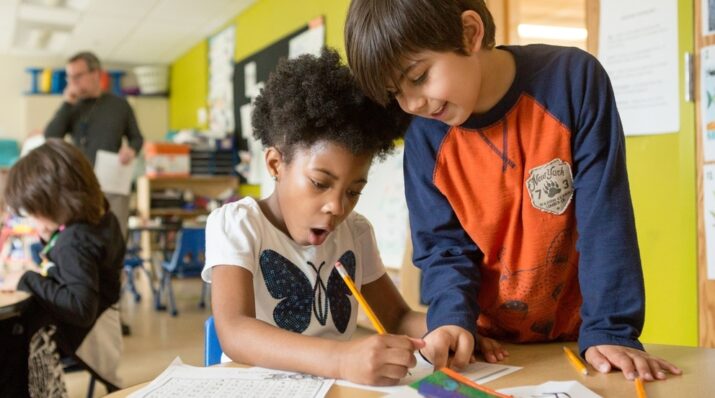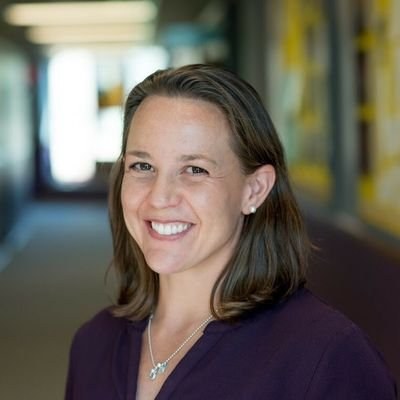New Designs for School
A Shift in Literacy Instruction in a Primary Classroom
Topics

We’ve all had the experience of truly purposeful, authentic learning and know how valuable it is. Educators are taking the best of what we know about learning, student support, effective instruction, and interpersonal skill-building to completely reimagine schools so that students experience that kind of purposeful learning all day, every day.
We can learn a lot from kids when they’ve been allowed to truly use their voice and treated as an active player in the game of learning.
I am fortunate to work in a school and district where risk-taking is encouraged. It has been said in our building that we have invisible bungee cords attached to pull us back up the cliff after we jump into the unknown to try something new. Or there’s that saying of “you take the risk, and I’ll take the blame.” So often words can fall flat. However, at Trailblazer Elementary in Colorado Springs, those words and images could be a mantra posted on the walls. After hearing those words and seeing the truth behind our school and district’s support team, I decided to try out this concept during my literacy stations; I knew I had building and district coaches there to field questions and support me in my journey.
I was filled with crazy notions that second graders could do anything after teaching Kindergarten and Kindergarten/first grade combination classes! I started the year by giving them choices and independence with little guidance to see what would happen. I quickly learned that just because they were older didn’t mean they needed free reign over decisions in their learning. It was one of those ‘aha’ moments that I have every year when I try to shift my thinking. Instead of staying in my comfort zone, I tried asking the kids what they needed or wanted within a set of parameters that matched the standards they were required to master by October. I pored over curriculum and standards so that I had an idea of where we were headed by the time parent-teacher conferences came around. I looked at resources shared by our implementation team, and thought about how I could get the kids to understand the standards we were working toward.
Reflection and feedback are part of our professional culture, and we are encouraging this more with our learners as well.
A menu was the first thing that came to mind, and then I started thinking of my learners. We are a full inclusion school, and I wanted our learning to be valuable to all students in my class—not just the ones for whom a menu might work. I have always dreamed of using the ‘Must-Do’ and ‘May-Do’ menus that my teammates use.
Yet some of my students struggled with the freedoms of 'May-Do.' When we reflected on it, I was surprised by the responses. For example, one student said, “If it says ‘May-Do’ that means I may or may not really need to do it. It may not be that important.” I was amazed by their thoughts. We decided on a priority list with the ‘Should-Do’ items highlighted at the top. I shared my ideas and vision with our building coach who gave suggestions to help with the organization for the kids as well as the accountability piece of their learning; the list is in its fourth iteration so far and will keep changing as needed.
The priority list was good on its own, but it wasn’t quite what I had envisioned for the academic reflection. We typed out the literacy and math standards that we are targeting for the quarter, set goals based on data, and then added choices to our priority list based on those goals. My small instructional groups were based around students’ literacy goals. I taught five seminars, and they attended at least one that matched their needs. They determined when they needed to learn with me and sometimes they chose to participate in two or three groups with me for extra practice or multiple goals. There are a couple of kids that ask for support in what they need, and they are given their own ‘bungee cord’ to aid their choices.
Reflection and feedback are part of our professional culture, and we are encouraging this more with our learners as well. These learning activities are built into our Friday schedule so we can review our priority list and see what students have achieved toward it, and what they still need to work on. Have they met their goal? How will they know when they have mastered that skill? We highlight the goal they are working on, talk about what they’ve achieved toward their goal, give feedback on their work for the week, and then set our sights on what we will work on for the following week. Color coding with scented markers is a great way to help second graders stay on task, and will fill the room with giggles as they sniff their papers days later!
We’re now four weeks into the school year, and I am excited by our literacy stations so far. The kids know what they are learning and why. They recognize that they have not yet mastered the skills, and put some steps and supports into place to help them achieve success. I am encouraged and inspired by the learners in my classroom and the team of professionals holding my ‘bungee cord of support’ in my educational journey.
Kids can tell educators what they need, if we take the time to truly listen. We can learn a lot from kids when they’ve been empowered to use their voice and are treated as active players in the game of learning. Give them the skills they need, the direction they should head toward, and they will create the path that works for them.
Top photo courtesy of Allison Shelley/The Verbatim Agency for American Education: Images of Teachers and Students in Action.




